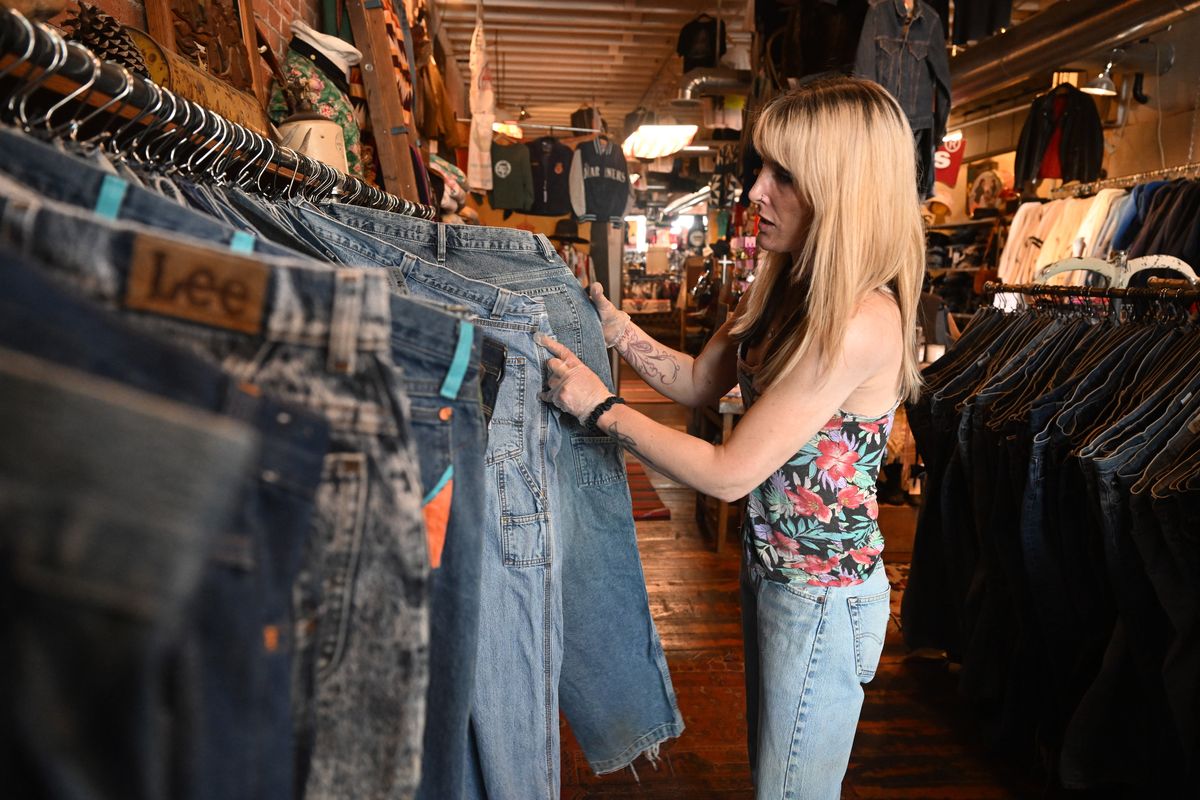Jorts, Crocs and baggy jeans make a comeback as Y2K resurgence hits Spokane vintage shops

If you stumble into one of Spokane’s thrift stores these days, you may be taken back to the colorful clothing era of celebrities like Christina Aguilera, Lindsey Lohan and, of course, fictional HBO fashionista Carrie Bradshaw. Stores are filling up with droves of denim, strappy 2000s tank tops and baggy T-shirts made popular around the turn of the millennium.
From the street to the store, it seems those once-forgotten clothing trends are re-entering the spotlight. “Modern” fashion is closer to the opposite, with staples from the Y2K era long seen as tacky making a resurgence.
Trends tend to come in and out of style every 20 years or so, said Jihyeong Son, an associate professor at Washington State University’s Department of Apparel, Merchandising, Design and Textiles.
That means right now, the “most noticeable is the early 2000s. I think there are lots of indicators for that,” Son said.
Nostalgia, social media and cultural influences contribute to trends’ returns, Son said.
Brandi Duval with Teleport Vintage in Spokane hypothesizes that as early 2000s fashions come out of closets and back into secondhand circulation, “it’s just really easy to find and it’s accessible… It’s really just sourcing.”
When these trends reappear, they often see modifications. For example, higher waistlines of the 1980s are being paired with 2000s tank tops, Son has noticed. These two styles arise from different decades, but the modern wearer meshes them together.
With the rise of secondhand shopping as a cheap and eco-friendly option, many trends thought to have died decades ago are seeing a resurgence.
“The vintage world has changed a lot in the past five or six years,” Duval said. “Ultimately, post-COVID, it has done a 180 – thrifting has become a norm.”
Denim, a versatile and durable fabric that has been around for more than a century, hasn’t gone out of style; in fact, it’s more prevalent than ever.
“Denim, crewnecks – I would say those are two really big sellers,” Duval said.
When Duval thinks about retro trends back in style, the first thing that comes to mind are baggy skater JNCO jeans from the ’90s.
“JNCOs are huge again,” Duval said.
Other iterations of the enduring fabric are also coveted.
“Most of the younger kids that come in here – if I ask them if they’re looking for anything in particular, if they have anything to say – the first thing is ‘Do you have cargo jorts?’ ” Duval said of the portmanteau for a once-mocked men’s style: jean shorts.
Abel Avila, a vendor at Chosen Vintage on Main Avenue in downtown Spokane, said that when it comes to fashion these days, “the looser, the baggier, the better.”
His main sellers are jeans, T-shirts, Levi’s and anything Harley-Davidson.
The brand’s T-shirts in particular have been in demand, less so for the motorcycles and more for the spirit and nostalgia of the brand, Avila said.
Avila thinks that recurring trends have more to do with celebrity influence.
“It depends on who they see on social media, who wears it and whoever they’re listening to – songs, singers, artists, and if they see that trend, they’ll follow it,” Avila said.
Some things from the era that were never seen as cool have now apparently reached that status.
That includes Crocs clogs.
“I hated on (Crocs) forever, but they’re the most comfortable shoes,” Duval said. “I bought a pair, and I lived in them for months.”
The rise of the rubbery slippers has shocked some and delighted others. Their popularity could be from the many opportunities for fun pins and accessorizing options.
Looking ahead, Son anticipates the trend pendulum to swing.
An example: though baggy pants are popular as of now, shoppers could see tighter styles hit the shelves once more.
“It’s based on the cyclical nature of fashion,” she said.